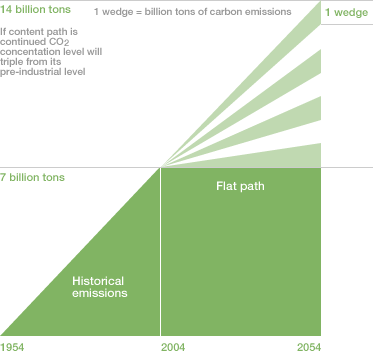Climate Change Emissions and Stabilization
Climate change is the result of an increase in heat-trapping (greenhouse) gases in the atmosphere. Carbon dioxide (CO2) is the major long-lived greenhouse gas (GHG). CO2 results from the combustion of fossil fuels in human activities, including manufacturing; power generation; residential burning; and the transportation of people and goods.
Globally, emissions from light-duty vehicles comprise about 11 percent of all fossil fuel CO2 emissions. Cars and light-duty trucks account for approximately 19 percent of fossil fuel CO2 emissions in the United States, or approximately 4 percent of global fossil fuel CO2 emissions. In Europe, passenger cars and light-duty trucks account for approximately 17 percent of fossil fuel CO2 emissions, or about 3 percent of global fossil fuel CO2 emissions (see Distribution of CO2 Emissions).
The updated assessment of the science of global warming issued in February 2007 by the Intergovernmental Panel on Climate Change concluded that, "Most of the observed increase in global average temperatures since the mid-20th century is very likely due to the observed increase in anthropogenic [man-made] greenhouse gas emissions." It also concluded that the effects of this warming, such as melting snow and ice and rising sea levels, are being felt, and that, "Continued greenhouse gas emissions at or above current rates would cause further warming and induce many changes in the global climate system during the 21st century that would very likely be larger than those observed during the 20th century."1
Ford researchers have played a leading role in scientific research to understand and quantify the contribution of vehicles to climate change. We have also worked with a variety of partners to understand current and projected man-made GHG emissions and steps that can be taken to reduce them. Many scientists, businesses and governmental agencies have concluded that stabilizing the atmospheric concentration of CO2 may help to forestall or substantially delay the most serious consequences of climate change.
The Carbon Mitigation Initiative, a research partnership based at Princeton University and supported by BP and Ford, has examined what it would take to stabilize atmospheric CO2 at 500 parts per million (ppm) compared with the level in 2008 of approximately 385 ppm and the pre-industrial level of approximately 270–280 ppm. Researchers identified a set of stabilization strategies they call "wedges." Each wedge represents the implementation of a strategy that could cut global annual carbon emissions by 1 billion metric tons by 2054. The diagram below shows that stabilization would require the successful implementation of at least seven of these 15 approaches to achieve the annual reduction of 7 billion metric tons of carbon emissions from business-as-usual forecasts.

While the wedges may be theoretically achievable, they were not evaluated for their economic, market or political feasibility. Many would require the rapid scale-up of emerging technologies. Nevertheless, the wedges approach helps to highlight the challenge of achieving meaningful reductions in greenhouse gases.
According to the Princeton researchers, each of the following strategies has the potential to reduce carbon emissions by one wedge.
Efficiency
- Double the fuel efficiency of 2 billion vehicles
- Decrease the number of vehicle miles traveled by half
- Use best efficiency practices in all residential and commercial buildings
- Produce current coal-based electricity with twice today's efficiency
Biomass Fuels
- Increase ethanol production 50 times by creating biomass plantations with an area equal to one-sixth of world cropland
Carbon Capture and Storage
- Capture and store emissions from 800 coal electric plants
- Produce hydrogen from coal at six times today's rate and store the captured CO2
- Capture carbon from 180 coal-to-synfuels plants and store the CO2
Nuclear
- Add double the current global nuclear capacity, to replace coal-based electricity
Wind
- Increase wind electricity capacity by 50 times its present value, for a total of 2 million large windmills
Solar
- Install 700 times the current capacity of solar electricity
- Use 40,000 square kilometers of solar panels (or 4 million windmills) to produce hydrogen for fuel cell vehicles
Fuel Switching
- Replace 1,400 coal electric plants with natural gas-powered facilities
Natural sinks
- Eliminate tropical deforestation and create new plantations on non-forested land to quintuple current plantation area
- Adopt conservation tillage in all agricultural soils worldwide
RELATED LINKS
- External Web Sites